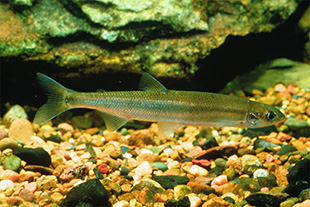
DRAFT PAS actions for Australian Grayling – adopted from the National Recovery Plan

Collate and review existing information
Collate existing data on distribution, abundance and population parameters (Medium priority).
Community and stakeholder liaison, awareness and education
Ensure research findings are publicised and incorporated into catchment management and river health programs where appropriate (High priority).
Promote angler awareness of conservation of Australian Grayling where incidental capture is likely to be an issue (Medium priority).
Enhance, modify or implement NRM planning processes to minimize adverse impacts on threatened species.
Identify rivers where flow regulation or water abstraction potentially impacts on important populations and habitats of
Australian Grayling, and ensure conservation requirements are included in river management processes (High Priority).
Habitat protection
Protect and restore riparian habitat in catchments supporting Australian Grayling populations, with priority to those catchments supporting important habitat/populations (High priority).
Habitat rehabilitation
Ensure Australian Grayling conservation requirements are included in fishway programs (High priority).
Pest eradication and control
Investigate the impact of trout on Australian Grayling (High priority).
Ensure important populations and locations are protected from stocking of trout (High priority).
Research / monitoring
Investigate larval and juvenile distribution, habitat and movements (High priority).
Undertake a genetic assessment of population structure throughout range (Medium priority).
Identify populations and locations for long-term monitoring, especially to determine population trends and responses in locations where recovery actions are occurring (eg. fishway installation, catchment protection) (Medium priority).
Investigate spawning cues, particularly the influence of river flows (Medium priority).
Investigate adult distribution, habitat and movements (Medium priority).
Investigate the potential for predation on larvae/juveniles in estuarine environments (Low priority).
Investigate the impact of increased sedimentation on Australian Grayling and habitats in catchments affected by wildfires (Low priority).
Survey / mapping
Determine gaps in distribution data and undertake surveys to determine presence and significance of grayling populations in areas poorly surveyed (High Priority).
Identify and map important habitat (rivers/locations), particularly for recruitment and as potential drought refuge habitat (High Priority).
Acquire baseline data on selected populations by conducting surveys including (a) identification of the area and extent of populations; (b) estimates of the size and structure of populations; (c) inference or estimation of population change and (d) habitat quality (Medium Priority).
*(NB: the PAS actions for Australia Grayling are taken from the approved Commonwealth recovery plan for this species. The department will be responsible for implementing only those actions of relevance to NSW).

